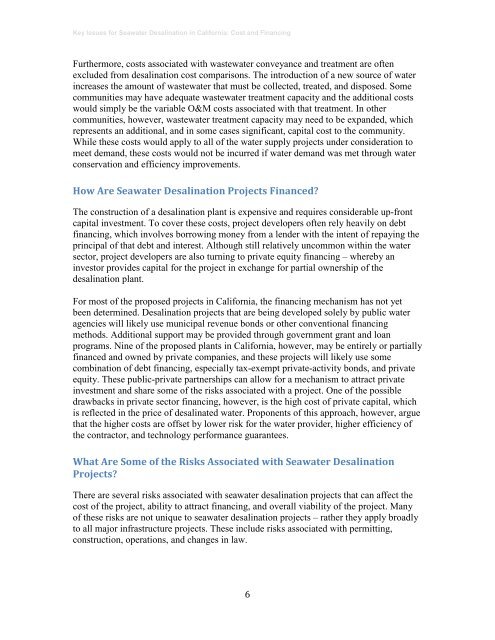997.4 KB - San Francisco Bay Area Independent Media Center
997.4 KB - San Francisco Bay Area Independent Media Center
997.4 KB - San Francisco Bay Area Independent Media Center
Create successful ePaper yourself
Turn your PDF publications into a flip-book with our unique Google optimized e-Paper software.
Key Issues for Seawater Desalination in California: Cost and Financing<br />
Furthermore, costs associated with wastewater conveyance and treatment are often<br />
excluded from desalination cost comparisons. The introduction of a new source of water<br />
increases the amount of wastewater that must be collected, treated, and disposed. Some<br />
communities may have adequate wastewater treatment capacity and the additional costs<br />
would simply be the variable O&M costs associated with that treatment. In other<br />
communities, however, wastewater treatment capacity may need to be expanded, which<br />
represents an additional, and in some cases significant, capital cost to the community.<br />
While these costs would apply to all of the water supply projects under consideration to<br />
meet demand, these costs would not be incurred if water demand was met through water<br />
conservation and efficiency improvements.<br />
How Are Seawater Desalination Projects Financed?<br />
The construction of a desalination plant is expensive and requires considerable up-front<br />
capital investment. To cover these costs, project developers often rely heavily on debt<br />
financing, which involves borrowing money from a lender with the intent of repaying the<br />
principal of that debt and interest. Although still relatively uncommon within the water<br />
sector, project developers are also turning to private equity financing – whereby an<br />
investor provides capital for the project in exchange for partial ownership of the<br />
desalination plant.<br />
For most of the proposed projects in California, the financing mechanism has not yet<br />
been determined. Desalination projects that are being developed solely by public water<br />
agencies will likely use municipal revenue bonds or other conventional financing<br />
methods. Additional support may be provided through government grant and loan<br />
programs. Nine of the proposed plants in California, however, may be entirely or partially<br />
financed and owned by private companies, and these projects will likely use some<br />
combination of debt financing, especially tax-exempt private-activity bonds, and private<br />
equity. These public-private partnerships can allow for a mechanism to attract private<br />
investment and share some of the risks associated with a project. One of the possible<br />
drawbacks in private sector financing, however, is the high cost of private capital, which<br />
is reflected in the price of desalinated water. Proponents of this approach, however, argue<br />
that the higher costs are offset by lower risk for the water provider, higher efficiency of<br />
the contractor, and technology performance guarantees.<br />
What Are Some of the Risks Associated with Seawater Desalination<br />
Projects?<br />
There are several risks associated with seawater desalination projects that can affect the<br />
cost of the project, ability to attract financing, and overall viability of the project. Many<br />
of these risks are not unique to seawater desalination projects – rather they apply broadly<br />
to all major infrastructure projects. These include risks associated with permitting,<br />
construction, operations, and changes in law.<br />
6
















